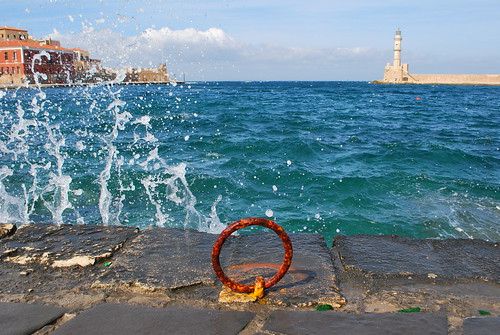When Tara and I left to embark on this adventure, neither of us knew a thing about photography. In fact, we'd planned on bringing a run of the mill point-and-shoot with us until my friend Ian Meyer wisely convinced me to buy a DSLR.
Since then, we've recieved so many comments and emails asking about our photos, camera, lenses, and post-processing efforts, that I decided when we had some free time I'd write a journal entry about it. For the next week, we are waiting for our Russian visas in Athens. So, here we go!
We carry a Nikon D60 and the kit lens, a AF-S Nikkor 18-55 f/3.5-5.6G VR. We also have a Dolica battery charger that accepts DC input (cigarette lighters etc), a 4GB SD card and a nice lintless cloth for cleaning the lens (we do not use protective filters). We carry all of this strapped to the back of my bicycle in a ThinkTank Digital Holster 10. That's it!
For the first six months, we shot nearly every photo in manual mode (M), with autofocus on. I wanted us to have a firm, experience-based understanding of how apeture, shutter speed, ISO and white balance work. It was a great learning experience. Now, we take 90% of our photos in program mode (P) which is much, much easier.
For those that are really curious about specifics: we shoot entirely in Vivid Mode with Noise Reduction off and Active D-Lighting on. Because we spend almost all of our time outdoors, we use "cloudy" white balance the most. This makes our photos a little warmer in color when the sun isn't shining. In fact, we like the look so much so we just leave it there when the sun is out too. Less time fiddling with settings means more time capturing photos of the world around us.
Because we take so many pictures, we don't spend a lot of time editing them. The most important part of our post-processing workflow is deleting. The only time we don't trash a lousy photo is when it documents something we really care about. These crappy shots are invariably the ones we spend the most time mucking with and they always look terrible compared to any that were good straight out of our camera.
 Unedited from Nikon D60
Unedited from Nikon D60Click on photo to cycle through different post-processing methods, or choose from the buttons below.
Until recently we used the free software Picasa, exclusively for post-processing. Generally the only edit we did was a slight bump on the "shadows" slider. This, according to Picasa, darkens the shadows in the photo to add contrast or depth. Clicking on the photo above shows this effect, which we use on nearly every photo we take. Then, we upload. That's it.
About a month ago, we started using Digital Optics Pro (DxO). The end result, as shown above, isn't that different. Our switch was mostly because I began to notice the barrel distortion our lens exhibits at the wide end (zoomed all the way out). Barrel distortion is when straight lines away from the center of the frame bow outward, giving the appearance that a photo is wrapped around a sphere. It really bugs me! Picasa can't fix this, but DxO can.
When we first got DxO, we spent a lot of time tinkering with the settings to make a "preset" which was close to what Picasa had been giving us (with the added benefit of fixing my geometrical nitpicks and a bunch of other technical crap that nobody but photographers and stuffy artists care about). Now, after we import our photos we just run them through DxO, giving each a quick glance before we process them en masse to upload.
Another side benefit of using DxO is that our photos come out about 20% smaller, making for faster uploads! We save our JPGs from the program at 90% quality. Comparisons at original size with anything higher are so minuscule that the decreased filesize is well worth whatever unseen tradeoff there might be. We don't even save our originals. DxO isn't free, but you can download the demo here.
As a side note, even though our pictures are on a Flickr account in my name (in retrospect it would have been nice to start a Going Slowly account, but it's too much of a pain to turn back now), it is a pretty even 50/50 split on who takes the photos. There are just two notable exceptions: bugs are usually me, flowers are usually Tara!
That pretty much sums up our first year of learning how to take photographs.
UPDATE:
A few days after this writing, our trial period of DxO expired. We then decided to give the Lightroom 3 Beta (free at the time) a shot. We fell in love with it, and now use it for all of our photo editing.